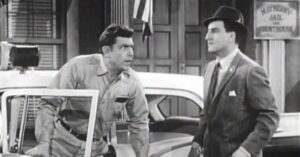
The spirit of Mayberry confounds the liberal media
In one of its National Geographic-like expeditions into “everyday America,” the legacy media invaded Mount Airy, North Carolina, better known as Mayberry USA.
Veteran journalist Ted Koppel was curious. He wondered why, 54 years after its last live TV season in 1968, “The Andy Griffith Show” still draws millions in reruns and thousands of tourists to Mount Airy, Griffith’s boyhood home.
Like Mayberry, Mount Airy exemplifies small-town America, and it has embraced its stand-in role with gusto, complete with the Andy Griffith Museum, the Snappy Lunch, Wally’s Filling Station, Floyd’s Barber Shop and lots of souvenirs for sale.
Most of the original cast are now dead, including Betty Lynn, who played Deputy Barney Fife’s girlfriend Thelma Lou. She passed away on October 16, 2021, a few weeks after the segment was filmed.
The 13-minute segment was shot in June and aired on CBS Sunday Morning in September. It has garnered nearly 200,000 views on YouTube.

Last month, The Washington Post ran a style-section piece about the CBS feature titled, “They believe in Mayberry but suggest Jan. 6 was staged.” Wow, what a bunch of hicks.
The runover page headline was worse: “Koppel hears dog whistle themes in the town that claims it inspired Mayberry.”
The term “dog whistle” is how leftists accuse someone of being a racist, which is pretty much everyone to the right of Stacey Abrams.
The recurring theme of Mr. Koppel’s report is that the people who love Mayberry and its values are simple-minded folks who cannot differentiate fiction from reality. They are club-dragging primitives who are racists and still like former President Donald Trump, which is the same thing.
Mr. Koppel and Washington Post writer Emily Yahr go out of their way to remind us that Mount Airy is not Mayberry. “Its only connection to ‘The Andy Griffith Show’ is that Mount Airy was the real-life Griffith’s hometown,” Ms. Yahr writes. That’s a pretty strong connection, I’d say, even if the TV series were filmed in California.
Mr. Koppel interviews many tourists who say they love the show and watch it often.
“People looking back at that program seems to confuse the program with what reality was like in those days, wishing that we could only restore some of the good feelings, some of the kindness, some of the decency,” Mr. Koppel says.
He adds this corrective: “What they’re reflecting on is what was going on in the creative minds of a bunch of scriptwriters in Hollywood.” Later, he says, “It captured a reality that never was.” Really? There are no sweet little towns anywhere?
The show is and was phenomenally successful because it has timeless plots animated by virtues still found all over America.
Several minutes into the segment, we see news clips from the 1960s, including the Vietnam War, John F. Kennedy’s assassination and the civil rights struggle. The implication is that the TV show did not reflect American life in any way; it was just an escape cooked up in Hollywood. They also noted that the cast was virtually all-white, which it was until a Black coach was added near the end.
